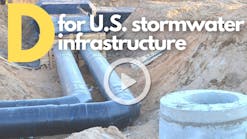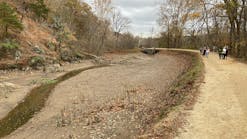About the author:
Sarah Sojka is associate professor at Randolph College and vice president of the ARCSA Foundation. Sojka can be reached at [email protected].
by Sarah Sojka
undefinedActive rainwater harvesting systems collect runoff from roof surfaces to store for later beneficial use. These uses can include irrigation, toilet flushing, cooling tower make-up water, laundry, vehicle washing and more.
Views on Rainwater
Active rainwater harvesting is distinct from passive rainwater harvesting, which directs runoff to landscape areas and does not include storage in a tank, and storm water harvesting, which collects water from surfaces, such as parking lots and lawn areas. Active rainwater harvesting is an ancient technique that was developed to provide drinking water. However, in many areas, the storm water management benefits of rainwater harvesting are at least as significant.
Unfortunately, many people assume that a single active rainwater harvesting system cannot be an effective tool for both water supply and storm water management. This misconception often stems from a belief that to be effective for water supply, a rainwater harvesting system must meet all of the demand on the system or from a perception of a rainwater harvesting system as an emergency water supply that must be used as minimally as possible so that water is available when needed. When rainwater harvesting is used in this way, or as the sole water source, maximizing the storm water management benefits can be challenging. However, rainwater harvesting is most typically used as a supplemental water source backed up by either municipal water or groundwater.
On the other extreme, many designers think that a rainwater harvesting system must be designed and managed like a detention pond with the water drained over a few days to make room for the next storm. When a system is designed in this way, the system can be effective at minimizing runoff but is ineffective for water supply. Making a rainwater harvesting system effective for both storm water management and water supply requires moving away from these preconceived notions and starting with the simple notion that every gallon of water used in a rainwater harvesting system is a gallon of runoff reduced. Once this simple framing is adopted, seeing how a system can effectively be a water source and a part of a storm water management treatment train is easy.
Looking at the Numbers
A hypothetical rainwater harvesting system collecting runoff from a 10,000 cubic-foot roof footprint in Richmond, Virginia, can be used to illustrate this point. Using the Cistern Design spreadsheet from the Virginia Stormwater BMP clearinghouse, numerous scenarios for using and releasing water from the storage tank are considered:
Base case – The rainwater harvesting system is supplying an 800 gallon per day water use (equivalent to toilet and urinal flushing for 200 people) Monday through Friday.
Decreased demand - Daily water use (Monday through Friday) is decreased to 400 gallon per day (for example, by only supplying a portion of the toilets and urinals in the building). In this scenario, the rainwater harvesting system is able to meet 95 to 99% of the water demand.
Storm water release - In addition to the 800 gallon per day demand of the base case, 2,000 gallons of water per day are released from the system to make space for the water quality design storm (1 inch) in three days, even during the weekend.
The Cistern Design Spreadsheet uses historical daily rainfall data to model the behavior of rainwater harvesting systems through time. The spreadsheet models a range of cistern sizes based on the active storage volume, the portion of the cistern above any dead water area below a pump intake, spigot or low-water valve and below the overflow. The spreadsheet calculates the runoff reduction credit based on the volumetric reduction in runoff from storms 1 inch or less. This runoff reduction is used to meet water quality storm water guidelines. For rainwater harvesting, the reduction in nutrient loads is assumed to be proportional to the reduction in runoff volume.
In the base case with 7,000 of active cistern storage, the rainwater harvesting system meets 74% of the water demand and represents an 82% runoff reduction credit for the roof area. This represents an average annual water savings of 153,000 gallons and reduces the overflow from the system (runoff from the roof that is not able to be stored in the storage tank) to 85,000 gallons per year. This system provides both substantial water savings and, by providing a runoff reduction credit for most of the roof area, a substantial part of the storm water management plan.
In the decreased demand scenario, while a rainwater harvesting system with the same size storage tank would meet a higher percentage of demand (95%), the total volume of water supplied annually is 35% lower (100,000 gallons), and the runoff reduction credit is reduced to 58%. This system is therefore less effective at both runoff reduction and water supply. In the storm water release scenario, the runoff reduction credit is 98%, but only 23% of the water supply demand is met (60,000 gallons per year). When larger storage tanks (10,000 and 13,000 gallons of active storage) are considered, the trends all remain. This example demonstrates that effective water supply and runoff reduction are possible as long as the system is designed to balance these two goals, as in the base case.
This example focuses on the water quality benefits of rainwater harvesting through reduction of storm water volume leaving the site. In general, rainwater harvesting systems are most effective at minimizing the runoff from small and medium storms. For example, in the base case scenario, the 7,000 gallon rainwater harvesting system would capture 82% of the total volume of all storms less than 1 inch and 64% of the total annual runoff volume, meaning that during larger storm events, a higher percentage of water overflowed the cistern. Even if the rainwater storage tank was empty at the start of a storm, the tank could not fully contain a storm much greater than 1 inch. Because of this greater effectiveness in small storms, the flood reduction benefits of rainwater harvesting have often been downplayed. However, small storms and their associated floods are far more common than larger storms and floods. While the impact from each small storm is, like the storm, relatively small, in many cities the cumulative economic impact of these frequent, small storms can be greater than the impact of infrequent, large storms. Because of this, the flood reduction benefits of rainwater harvesting systems can be substantial.
Evaluating Effectiveness
Many of the perceived hurdles to using rainwater harvesting effectively for storm water management stem from misguided expectations. A rainwater harvesting system can be effective for water supply and storm water management but not if the system is expected to do a perfect and complete job of both. Similarly, a rainwater harvesting system can mitigate flood damage but is generally not appropriate for completely managing large storms. Adding additional design features to the rainwater harvesting system can make it better suited to meet these goals. Controlled releases of harvested rainwater, either based on the water level in the storage tank or predicted rainfall, can substantially increase the runoff reduction capacity of rainwater harvesting systems without significantly reducing the water supply capability. In addition, the storage tank for a rainwater harvesting system can be oversized, creating a detention volume in addition to the storage volume for reuse. When appropriately designed, a rainwater harvesting system can be a valuable tool for water supply, storm water management and flood control.






